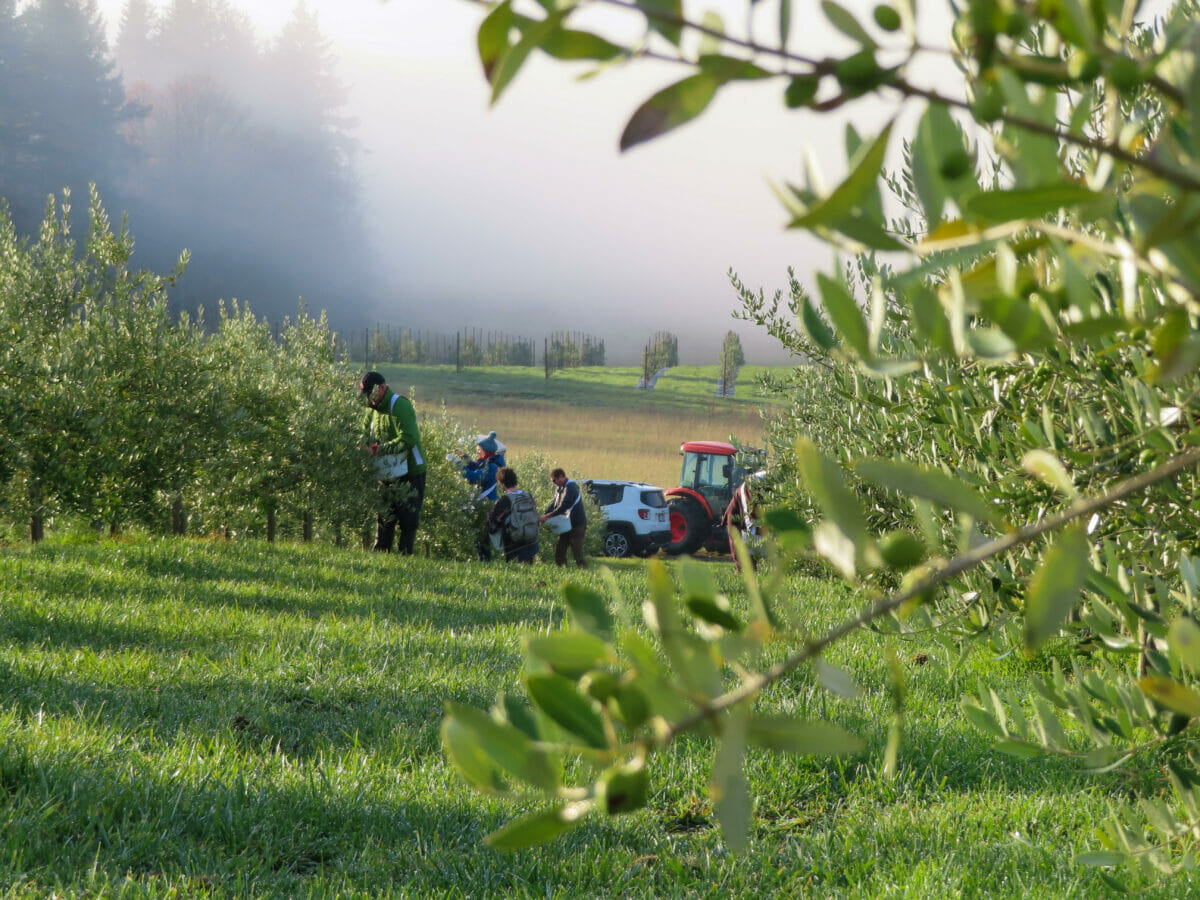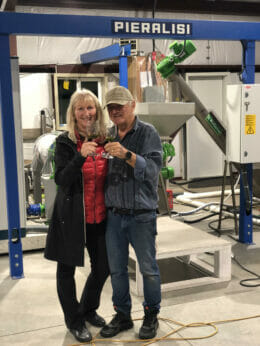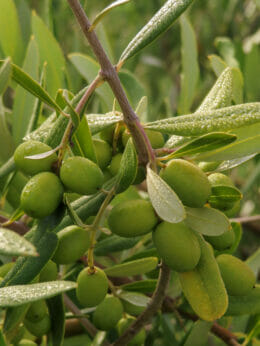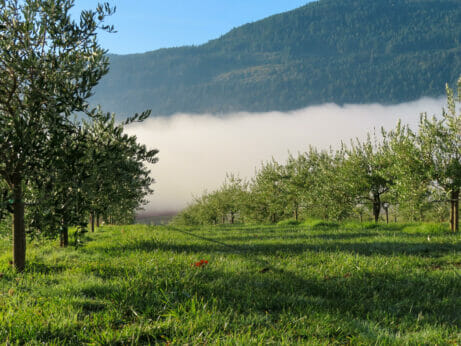As damaging heat waves become more frequent, the Pacific Northwest provides hope for adventurous olive growers willing to take a risk.

It was early December 2016, and the first real cold of the season was descending upon Salt Spring Island, British Columbia and The Olive Farm’s 72 acres was a flurry of activity. Sheri and George Braun, the grove’s owners, had waited until the last possible moment before the onslaught of winter weather to make sure the olives had fully ripened. Now, with family and friends helping out, they were fervently picking the ripe green fruit.
Eventually, they would bottle eight and a half gallons of extra virgin olive oil, the first commercial-grade olive oil produced in Canada. It wasn’t a lot. Olive trees are slow growers, taking at least four years to produce fruit. Many of the trees on the Brauns’ property were still maturing, only just reaching their fourth birthday, and still too young to produce fruit. But, despite the low yield, it was enough to give the Brauns the inspiration they needed.

Sheri and George Braun.
Photography submitted.
Other than the hobbyist who plants a few trees in their garden or patio pots, olive farming has traditionally been considered ill suited for Canada’s unpredictable cold weather. But, with heat intensifying in traditional olive-growing regions around the world, places such as Oregon and the microclimate of British Columbia’s Gulf Islands have become unlikely olive oil hubs.
Since 2020, the olive-producing regions of northern California have experienced increasingly intense heat in the low hundreds. Heat waves have also accelerated in Europe over the past several decades. Spain produces 57% of the world’s olive oil, and this past April, just as the olive trees were in blossom, temperatures in many regions soared.
The Brauns are in a sweet spot of west-coast geography. Salt Spring Island is part of a larger archipelago of islands between the mainland of southern British Columbia and Vancouver Island. The warming currents of the Pacific Ocean meet the Salish Sea and create a rain-shadow effect and moderate temperatures encompassing the region. The climate is often compared to the olive-producing regions of northern Italy, Portugal or Spain.

Photography courtesy of The Olive Farm.
Michael Pierce operates Saturna Olive Consortium on neighbouring Saturna Island. He imports olive trees and sells them to local hobbyists. Despite the mild climate and an increase of frost-free days in British Columbia (a whopping three weeks since the middle of the last century), Pierce cautions that “growing olives in British Columbia is not for the risk averse.”
The sentiment is echoed by Lenore Newman, director of the Food and Agricultural Institute of the University of the Fraser Valley. “Climate change is making the average [temperature] warmer, but we are more likely to get erratic weather that includes deep arctic outbursts that are too cold for olive trees in most areas.”
Olive trees are sensitive. Ideally, they should be planted on a south-facing slope with well-draining soil to wick water away. If the roots get water-logged, they may not survive. Never truly dormant, they need periods of chill to tell them to stop producing for the season, but not too cold. Young trees are only able to withstand temperatures as low as 10 degrees F (-12 degrees Celsius). It’s intense heat, though, that may be their worst enemy. Although olive trees like warmth, they also have their limits, as many varieties are only able to tolerate temperatures to a maximum of 104 degrees F.

Photography courtesy of The Olive Farm
Despite The Olive Farm’s prime location, southern sloped exposure and the Brauns’ careful selection of cold-hardy varieties of olive trees (Leccino, Maurino and Frantoio), they’ve experienced challenges.
“It’s a really good thing we didn’t know what we know now when we bought the property in 2010, or we wouldn’t have embarked upon the project,” Sheri jokes. After planting their first trees in 2012, the couple had to wait four agonizing years to see if any would produce fruit. If that wasn’t hard enough, in November 2021, atmospheric rivers of rain pummelled British Columbia’s south coast. The Brauns lost 10 percent of their 3,000-tree grove. In late June 2021, just as their trees were blooming, a massive heat dome stretched from California into northern British Columbia, lasting almost a week.
“The trees survived, but the flowers withered,” says Sheri. Without flowers, there’s no fruit.
That alone might have been enough for some to throw in the towel, but a previous visit to an olive grove in Oregon State kept them motivated. Western Oregon has warm arid summers and mild wet winters—not dissimilar to Salt Spring.
Here, too, it’s getting hotter. According to a January 2023 report by Oregon State University’s Climate Change Institute, average temperatures in the state have increased by 2.2 degrees F since 1895 and are projected to increase by 5 degrees F by the 2050s and 8.2 degrees F by the 2080s.
Chris Barry is the agricultural manager of River Ranch Olive Farm, located in the southwestern corner of Oregon. River Ranch’s secret, much like The Olive Farm, is the micro-climate created by the gentle breezes of the North Umpqua River bordering the olive grove, which keeps the temperatures stable. “It takes determination to grow olives in this climate,” he says. “If the rain comes and the ground freezes, the trees are goners, especially the younger ones.”
On Salt Spring Island, the Brauns’ determination to grow olives has paid off. Their best harvest to date was in 2022, when the grove produced 89.5 gallons of Canadian extra virgin olive oil.
“We’re committed now,” says Sheri.